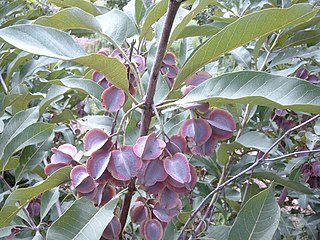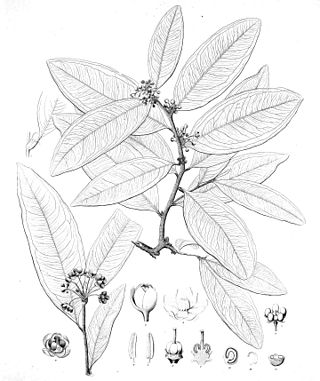
Combretum, the bushwillows or combretums, make up the type genus of the family Combretaceae. The genus comprises about 272 species of trees and shrubs, most of which are native to tropical and southern Africa, about 5 to Madagascar, but there are others that are native to tropical Asia, New Guinea and the Bismarck Archipelago, Australia, and tropical America. Though somewhat reminiscent of willows (Salix) in their habitus, they are not particularly close relatives of these.

Cissus is a genus of approximately 350 species of lianas in the grape family (Vitaceae). They have a cosmopolitan distribution, though the majority are to be found in the tropics.

The genus of the myrrhs, Commiphora, is the most species-rich genus of flowering plants in the frankincense and myrrh family, Burseraceae. The genus contains approximately 190 species of shrubs and trees, which are distributed throughout the (sub-) tropical regions of Africa, the western Indian Ocean islands, the Arabian Peninsula, India, and South America. The genus is drought-tolerant and common throughout the xerophytic scrub, seasonally dry tropical forests, and woodlands of these regions.

Cleome is a genus of flowering plants in the family Cleomaceae, commonly known as spider flowers, spider plants, spider weeds, or bee plants. Previously, it had been placed in the family Capparaceae, until DNA studies found the Cleomaceae genera to be more closely related to the Brassicaceae than the Capparaceae. Cleome and clammyweed can sometimes be confused.

Brackenridgea is a flowering plant genus of 11 species in the family Ochnaceae. The genus is named for the British-American botanist William Dunlop Brackenridge.

Campylospermum is a genus of flowering plants in the family Ochnaceae. It includes 55 species native to tropical Africa, India, Indochina, Hainan, and western Malesia.

Olax is a plant genus in the family Olacaceae. The name derives from the Latin, olax (malodorous), and refers to the unpleasant scent of some of the Olax species. Olax is an Old World genus represented by several climbers, some species have leaves and fruits smelling of garlic such as Olax subscorpioidea and Olax gambecola, seeds of the latter are used as condiments in parts of West Africa. In India Olax nana is well known as one of the first species to emerge after forest fires, the shoots growing directly from buried roots.

Xylopia is a genus of flowering plants in the family Annonaceae. They are mostly trees and some shrubs. There are about 160 species distributed in Asia, Africa, and the Americas.
Elvasia is a Neotropical genus of plants in the family Ochnaceae. It includes 14 species native to the tropical Americas, ranging from Belize to Bolivia and southeastern Brazil.
Colea is a genus of flowering plants belonging to the family Bignoniaceae.
Paropsia is a genus of flowering plants belonging to the family Passifloraceae.

Rhodocolea is a genus of flowering plants belonging to the family Bignoniaceae.









